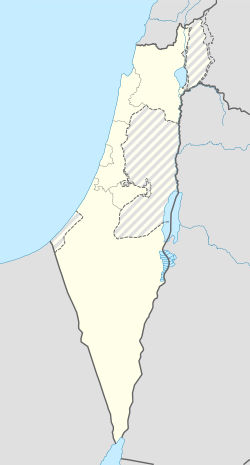|
Shlomi, Israel
Shlomi (Hebrew: שְׁלוֹמִי) is a town in the Northern District of Israel. In 2022 it had a population of 7,446. EtymologyShlomi was named after a leader from the tribe of Asher, mentioned in the Hebrew Bible (Num 34:27). History Shlomi was founded as a Ma'abara in 1950 by Jewish immigrants from Tunisia and Morocco on the ruins of a Palestinian village of al-Bassa, which had been destroyed during what the 1948 Arab–Israeli War,[2][3][4] and which Adolf Neubauer "proposed to identify... with the Batzet of the Talmud".[5] The Palestinian Arab village was stormed by Haganah troops in May 1948 and almost completely razed. Its residents were either internally displaced or expelled to neighboring countries.[6] Shlomi was the target of Hezbollah Katyusha rocket attacks on 11 May 2005, Israel's Independence Day, and again on Israel's Independence Day in 2006. It was again the target of rocket attacks on 12 July 2006, a diversion to facilitate the killing of three soldiers and kidnapping two others, which sparked the 2006 Lebanon War. On 6 April 2023, several rockets hit the town and caused damage to a street and a commercial center.(refactored) Israel–Hamas warDuring the 2023-24 war between Hamas and Israel, northern Israeli border communities, including Shlomi, faced targeted attacks by Hezbollah and Palestinian factions based in Lebanon, and were evacuated.[7] ArchaeologyPi Metzuba ruinsOn the road between Shlomi and Kibbutz Hanita, Israeli archaeologists found the remains of Pi Metzuba, a prosperous Christian town mentioned in the Jerusalem Talmud,[8] the Tosefta (Shevi'it 4:8-ff.) and in the 3rd-century Mosaic of Rehob.[9] The town was destroyed in the early seventh century when Persia invaded the region as part of its broader conflict with the Byzantine Empire.[8] Ma'sub inscriptionThe site of Khirbet Ma'sub, immediately to the east of the Arab village of Bassa, is where the Masub inscription was found before being purchased by the Louvre in 1885. Written in Phoenician script, the fragmentary Phoenician-language text, written in 222/21 BCE during Ptolemaic rule on a Hellenistic-style limestone stele, originates from a temple of Astarte and is on display at the Louvre.[10][11] References
External linksWikimedia Commons has media related to Shlomi.
|
||||||||||||||||||||||||||||||||||||



